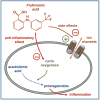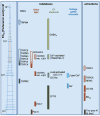Flufenamic acid as an ion channel modulator
- PMID: 23356979
- PMCID: PMC4116821
- DOI: 10.1016/j.pharmthera.2013.01.012
Flufenamic acid as an ion channel modulator
Abstract
Flufenamic acid has been known since the 1960s to have anti-inflammatory properties attributable to the reduction of prostaglandin synthesis. Thirty years later, flufenamic acid appeared to be an ion channel modulator. Thus, while its use in medicine diminished, its use in ionic channel research expanded. Flufenamic acid commonly not only affects non-selective cation channels and chloride channels, but also modulates potassium, calcium and sodium channels with effective concentrations ranging from 10(-6)M in TRPM4 channel inhibition to 10(-3)M in two-pore outwardly rectifying potassium channel activation. Because flufenamic acid effects develop and reverse rapidly, it is a convenient and widely used tool. However, given the broad spectrum of its targets, experimental results have to be interpreted cautiously. Here we provide an overview of ion channels targeted by flufenamic acid to aid in interpreting its effects at the molecular, cellular, and system levels. If it is used with good practices, flufenamic acid remains a useful tool for ion channel research. Understanding the targets of FFA may help reevaluate its physiological impacts and revive interest in its therapeutic potential.
Copyright © 2013 Elsevier Inc. All rights reserved.
Conflict of interest statement
The authors declare that there are no conflicts if interest.
Figures



Similar articles
-
Flufenamic acid is a pH-dependent antagonist of TRPM2 channels.Neuropharmacology. 2004 Sep;47(3):450-60. doi: 10.1016/j.neuropharm.2004.04.014. Neuropharmacology. 2004. PMID: 15275834
-
Flufenamic acid enhances current through maxi-K channels in the trabecular meshwork of the eye.Curr Eye Res. 2001 Jun;22(6):427-37. doi: 10.1076/ceyr.22.6.427.5485. Curr Eye Res. 2001. PMID: 11584342
-
Investigations on the mechanism of action of the antiproliferant and ion channel antagonist flufenamic acid.Naunyn Schmiedebergs Arch Pharmacol. 1996 Mar;353(4):452-60. doi: 10.1007/BF00261443. Naunyn Schmiedebergs Arch Pharmacol. 1996. PMID: 8935713
-
Induction of a novel cation current in cardiac ventricular myocytes by flufenamic acid and related drugs.Br J Pharmacol. 2010 Sep;161(2):416-29. doi: 10.1111/j.1476-5381.2010.00901.x. Br J Pharmacol. 2010. PMID: 20735425 Free PMC article.
-
Inhibitors of nonselective cation channels in cells of the blood-brain barrier.EXS. 1993;66:213-8. doi: 10.1007/978-3-0348-7327-7_16. EXS. 1993. PMID: 7505652 Review.
Cited by
-
Expressional and functional involvement of gap junctions in aqueous humor outflow into the ocular trabecular meshwork of the anterior chamber.Mol Vis. 2019 Apr 26;25:255-265. eCollection 2019. Mol Vis. 2019. PMID: 31205407 Free PMC article.
-
P2Y1 receptor-mediated potentiation of inspiratory motor output in neonatal rat in vitro.J Physiol. 2014 Jul 15;592(14):3089-111. doi: 10.1113/jphysiol.2013.268136. Epub 2014 May 30. J Physiol. 2014. PMID: 24879869 Free PMC article.
-
Modulation of Ether-à-Go-Go Related Gene (ERG) Current Governs Intrinsic Persistent Activity in Rodent Neocortical Pyramidal Cells.J Neurosci. 2018 Jan 10;38(2):423-440. doi: 10.1523/JNEUROSCI.1774-17.2017. Epub 2017 Nov 24. J Neurosci. 2018. PMID: 29175952 Free PMC article.
-
iPSC-Derived Trabecular Meshwork Cells Stimulate Endogenous TM Cell Division Through Gap Junction in a Mouse Model of Glaucoma.Invest Ophthalmol Vis Sci. 2021 Aug 2;62(10):28. doi: 10.1167/iovs.62.10.28. Invest Ophthalmol Vis Sci. 2021. PMID: 34427623 Free PMC article.
-
Multiple intrinsic membrane properties are modulated in a switch from single- to dual-network activity.J Neurophysiol. 2022 Nov 1;128(5):1181-1198. doi: 10.1152/jn.00337.2022. Epub 2022 Oct 5. J Neurophysiol. 2022. PMID: 36197020 Free PMC article.
References
-
- Aly FA, Al-Tamimi SA, Alwarthan AA. Determination of flufenamic acid and mefenamic acid in pharmaceutical preparations and biological fluids using flow injection analysis with tris(2,2’-bipyridyl)ruthenium(II) chemiluminescence detection. Analitica Chmica Acta. 2000;416:87–96.
-
- Baulac S, Huberfeld G, Gourfinkel-An I, Mitropoulou G, Beranger A, Prud’homme JF, Baulac M, Brice A, Bruzzone R, LeGuern E. First genetic evidence of GABA(A) receptor dysfunction in epilepsy: a mutation in the gamma2-subunit gene. Nature genetics. 2001;28:46–48. - PubMed
-
- Baumgarten CM, Clemo HF. Swelling-activated chloride channels in cardiac physiology and pathophysiology. Progress in biophysics and molecular biology. 2003;82:25–42. - PubMed
Publication types
MeSH terms
Substances
Grants and funding
LinkOut - more resources
Full Text Sources
Other Literature Sources

